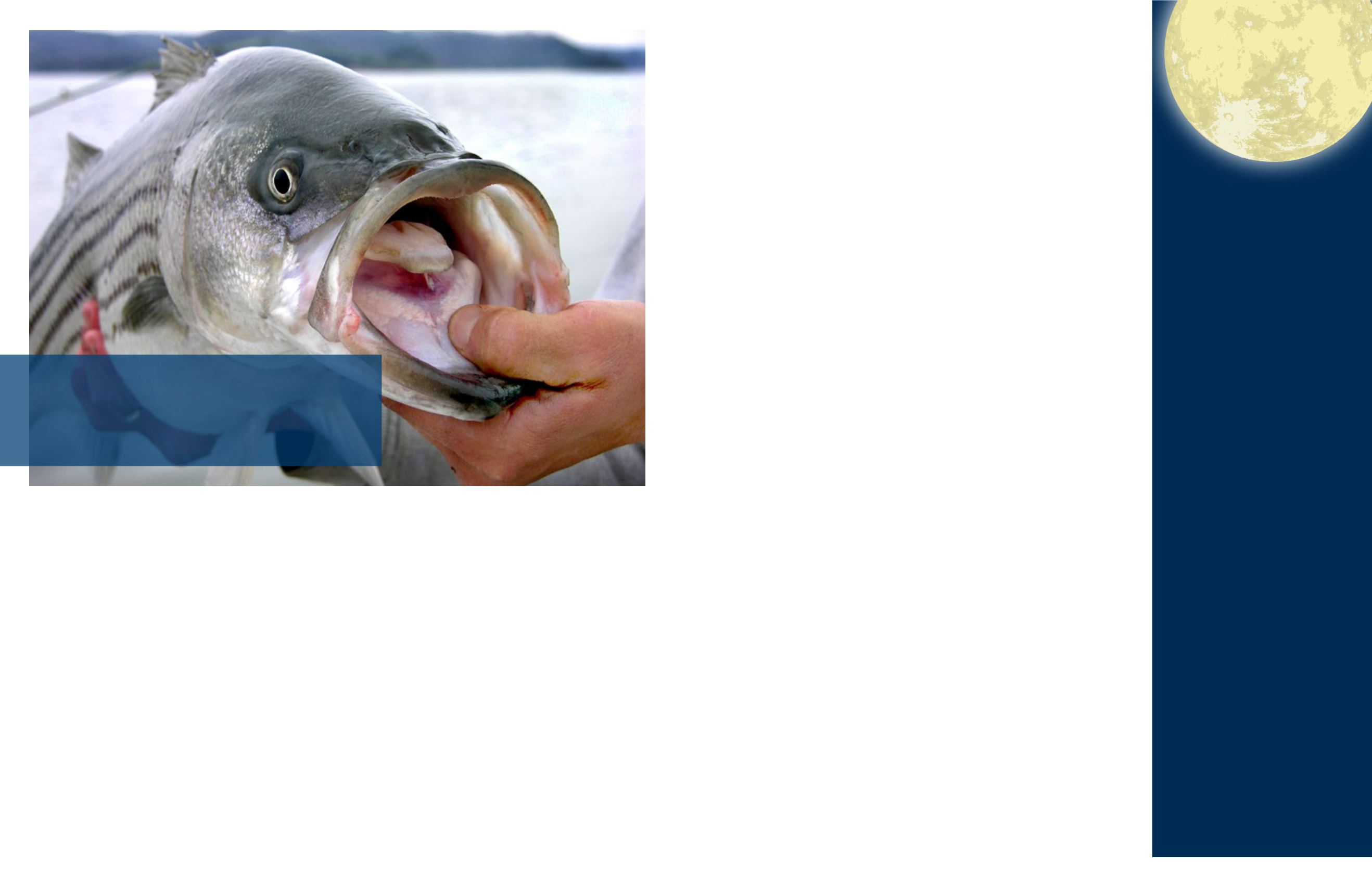
Discover Smith Mountain Lake
FALL 2016
21
20
21
A Rockfish is called a Rock, Striper. or Striped Bass depending on where you live or
fish. On the Atlantic coast it is called a Rock or Rockfish. In the inland waters, such
as Smith Mountain Lake and others, it is identified as a Striped Bass, or a Striper.
The Striped Bass (Morone saxatilis), also called Atlantic Striped Bass, Striper,
Linesider, Pimpfish, Rock, or Rockfish, is an anadromous Perciforme fish.This type
is defined as a perch-like fish that is born in fresh water and then spends most of
its life in the sea. It returns to fresh water to spawn. Salmon, Smelt. Striped Bass,
and Sturgeon are common examples. A catadromous fish does just the opposite: it
lives in fresh water, and enters the sea to spawn. Striped Bass are members of the
Moronidae (temperate basses) family, which is found primarily along the Atlantic
coast of North America, from Florida and the Gulf to Canada, especially in some
main inlets such as the Chesapeake Bay inVirginia and Maryland.
Almanac
Fisherman’s
What Is A Rockfish?
December 11th - NewMoon
December 25th - Full Moon
January 9 th - New Moon
January 23rd - Full Moon
February 8th - New Moon
February 22nd - Full Moon
March 8th - New Moon
March 23rd - Full Moon
April 7th - New Moon
April 22nd - Full Moon
May 6th - New Moon
May 21st - Full Moon
June 4th - New Moon
June 20th - Full Moon
July 4th - New Moon
July 19th - Full Moon
August 2nd - New Moon
August 18th - Full Moon
September 1st - New Moon
September 16th - Full Moon
September 30th - New Moon
October 16th - Full Moon
October 30th - New Moon
November 14th - Full Moon
November 29th - New Moon
December 13th - Full Moon
December 29th - New Moon
MOON PHASES
FOR 2016
On average, adult Striped Bass typically grow to be 2 or 3 feet in length, weighing
between 10 and 30 pounds, although they can get much larger. Their elongated
bodies vary in color from light or olive green to blue, brown, or black, and their
metallic sides are striped with seven or eight dark, continuous lines. Their bellies
are white.They have a dark, forked tail fin, with three spines on their anal fins.Their
dorsal fins feature a deep notch, and the forward portion has several spines.
Striped Bass is a mellow, sweet, white meat fish, and it was very much in demand at
markets and restaurants until overharvesting became a problem.This caused several
states to enact a moratorium on commercial fishing of this species. Sportsmen
can still fish for them in each area, but with limitations. This fish has also been
introduced in the Pacific Coast area with success.
When Santee-Cooper was built inTennessee, the Striped Bass had gone up the river
to spawn in this area.When it came time to close the dam and fill the lake, some of
the Striped Bass were still up the river. Engineers waited as long as was possible to
fill the lake, hoping that all the Striped Bass would have gone back to the sea, but
this was not the case. It was generally assumed that these fish would die, but the
Striped Bass is a euryhaline fish. That is, a fish that can adapt to fresh water, even
though it is normally a saltwater dweller. After the Striped Bass demonstrated that
they could thrive in fresh water, plans to stock in other lakes began.
The spawn occurs from April through early June, depending on the water
temperature and the full moon, most likely in May on Smith Mountain Lake. The
spawn on Smith Mountain Lake is called a “false spawn”. If a lake is fed by a river,
in which Striped Bass could go up stream far enough to spawn, and the eggs could
float and tumble for at least 72 hours before reaching the lake, the fish could have
a successful spawn.
However, if the Striped Bass can not reach the distance needed for the eggs to float
and tumble for at least 72 hours, the spawn will not be effective, resulting in no
offspring, and thus a “false spawn”. Such a lake is termed a “Put & Take” lake. In
other words, it must be stocked in order to maintain the Striped Bass population.
After a number of dead Striped Bass began showing up in the Chesapeake Bay,
the state of Maryland made a long intensive study to determine the cause. It was
determined that because of the fight that an adult Striped Bass will give an angler
in the summer months, the fish produces a large amount of lactic acid in its system,
and this becomes a big problem.The lactic acid can cause the fish to die after it is
returned to the water.
I’m sure you are aware of athletes getting muscle cramps that are severe enough
to cause knots in the muscles, and cause a lot of pain. As with most creatures, fish
require a consistent intake of oxygen in order to survive.Their gills absorb oxygen
from water molecules as the water passes through the gill membranes. Excessive
lactic acid can cause a problem for Striped Bass, resulting in their not being able
to pull water thru their gills, effectively “drowning” the fish.The mortality rate for
these fish in the summer is very high. In the cold water months, this is not so much
of a problem.
by Bob King


